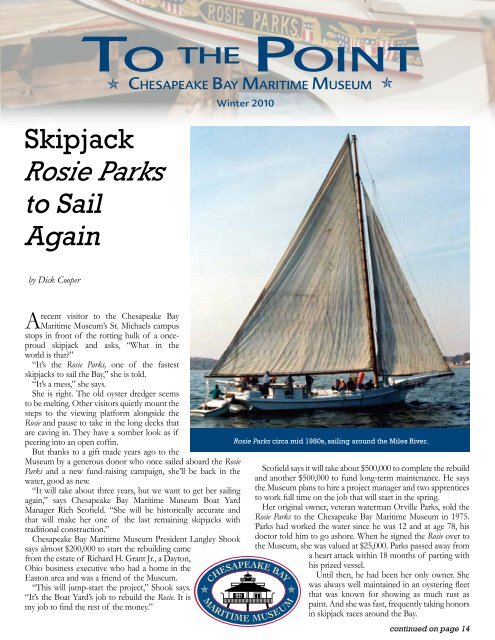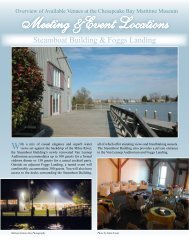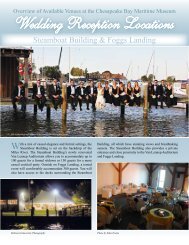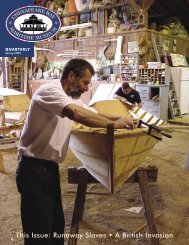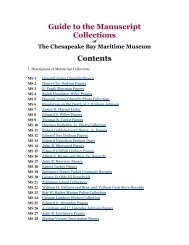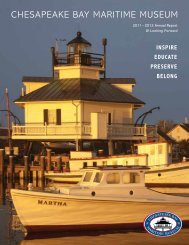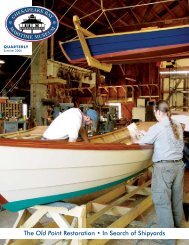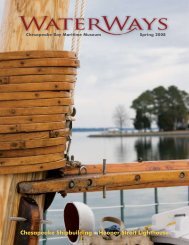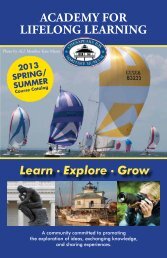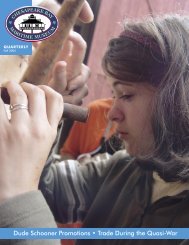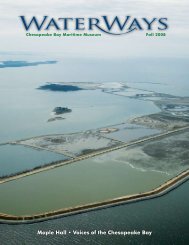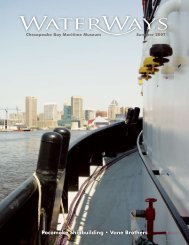Winter - Chesapeake Bay Maritime Museum
Winter - Chesapeake Bay Maritime Museum
Winter - Chesapeake Bay Maritime Museum
You also want an ePaper? Increase the reach of your titles
YUMPU automatically turns print PDFs into web optimized ePapers that Google loves.
To the Point<br />
<strong>Chesapeake</strong> <strong>Bay</strong> <strong>Maritime</strong> <strong>Museum</strong><br />
<strong>Winter</strong> 2010<br />
Skipjack<br />
Rosie Parks<br />
to Sail<br />
Again<br />
by Dick Cooper<br />
recent visitor to the <strong>Chesapeake</strong> <strong>Bay</strong><br />
A <strong>Maritime</strong> <strong>Museum</strong>’s St. Michaels campus<br />
stops in front of the rotting hulk of a onceproud<br />
skipjack and asks, “What in the<br />
world is that?”<br />
“It’s the Rosie Parks, one of the fastest<br />
skipjacks to sail the <strong>Bay</strong>,” she is told.<br />
“It’s a mess,” she says.<br />
She is right. The old oyster dredger seems<br />
to be melting. Other visitors quietly mount the<br />
steps to the viewing platform alongside the<br />
Rosie and pause to take in the long decks that<br />
are caving in. They have a somber look as if<br />
peering into an open coffin.<br />
But thanks to a gift made years ago to the<br />
<strong>Museum</strong> by a generous donor who once sailed aboard the Rosie<br />
Parks and a new fund-raising campaign, she’ll be back in the<br />
water, good as new.<br />
“It will take about three years, but we want to get her sailing<br />
again,” says <strong>Chesapeake</strong> <strong>Bay</strong> <strong>Maritime</strong> <strong>Museum</strong> Boat Yard<br />
Manager Rich Scofield. “She will be historically accurate and<br />
that will make her one of the last remaining skipjacks with<br />
traditional construction.”<br />
<strong>Chesapeake</strong> <strong>Bay</strong> <strong>Maritime</strong> <strong>Museum</strong> President Langley Shook<br />
says almost $200,000 to start the rebuilding came<br />
from the estate of Richard H. Grant Jr., a Dayton,<br />
Ohio business executive who had a home in the<br />
Easton area and was a friend of the <strong>Museum</strong>.<br />
“This will jump-start the project,” Shook says.<br />
“It’s the Boat Yard’s job to rebuild the Rosie. It is<br />
my job to find the rest of the money.”<br />
Rosie Parks circa mid 1980s, sailing around the Miles River.<br />
Scofield says it will take about $500,000 to complete the rebuild<br />
and another $500,000 to fund long-term maintenance. He says<br />
the <strong>Museum</strong> plans to hire a project manager and two apprentices<br />
to work full time on the job that will start in the spring.<br />
Her original owner, veteran waterman Orville Parks, sold the<br />
Rosie Parks to the <strong>Chesapeake</strong> <strong>Bay</strong> <strong>Maritime</strong> <strong>Museum</strong> in 1975.<br />
Parks had worked the water since he was 12 and at age 78, his<br />
doctor told him to go ashore. When he signed the Rosie over to<br />
the <strong>Museum</strong>, she was valued at $25,000. Parks passed away from<br />
a heart attack within 18 months of parting with<br />
his prized vessel.<br />
Until then, he had been her only owner. She<br />
was always well maintained in an oystering fleet<br />
that was known for showing as much rust as<br />
paint. And she was fast, frequently taking honors<br />
in skipjack races around the <strong>Bay</strong>.<br />
continued on page 14
President’s Message<br />
by Langley R. Shook, President<br />
“Dad, a bugeye has two masts, not<br />
one,” explained the seven-year old to<br />
his father, as they stood on the dock<br />
next to the 1889 Edna E. Lockwood.<br />
The boy pointed to Edna’s two masts and then he pointed<br />
to the skipjack, Lady Katie, in the next slip over. “See the<br />
difference?” the little boy said.<br />
“Yes, I do,” the dad replied and then nodded at me as<br />
the two ambled off in the direction of our Hooper Strait<br />
Lighthouse.<br />
I smiled to myself as I continued my walk around<br />
campus. It’s these interactions, overheard or observed<br />
almost every day that inspire each and every one of us to<br />
do our best work on behalf of the <strong>Museum</strong>.<br />
After all, where else can you immerse yourself in such a<br />
sense of place, so full of learning and wonder?<br />
Imagine a world without the stories of the <strong>Chesapeake</strong><br />
<strong>Bay</strong> and its skipjacks, and bugeyes, and watermen, and<br />
oysters, and crabs––imagine this and you begin to realize<br />
the value and the vibrancy this institution provides.<br />
One year into my tenure as just the fourth president in<br />
the <strong>Museum</strong>’s 45-year history, I know that your support<br />
now is more important than ever. Whether in the form of<br />
donations, membership, or volunteering, you are the critical<br />
force that keeps us moving forward and on course for<br />
historical relevance into the future.<br />
It’s because of support from people like you that we<br />
can announce the restoration of the legendary skipjack<br />
Rosie Parks; enroll all of Talbot County’s public elementary<br />
school students in our “Crab Cakes” program, unveil<br />
a newly designed and easier to navigate website, and install<br />
new exhibits in our Steamboat building for you and your<br />
guests to come back to enjoy time and again.<br />
So at a time when holiday expenses and everyday bills<br />
may beg of you to cut things out of your budget, we<br />
thank you for understanding that your support of the<br />
<strong>Chesapeake</strong> <strong>Bay</strong> <strong>Maritime</strong> <strong>Museum</strong> is a gift that helps to<br />
inspire and educate everyone we serve.<br />
On behalf of the <strong>Museum</strong>’s Board of Governors, staff<br />
and volunteers, we hope this edition of To the Point finds<br />
you surrounded by the warmth of the holiday season.<br />
And we thank you for the warmth of your support as we<br />
eye new horizons, while keeping this Jewel of the <strong>Chesapeake</strong><br />
such a treasured place for that little boy on campus, and for<br />
each of us to enjoy.<br />
Board of<br />
Governors<br />
2010-2011<br />
Joseph E. Peters, Chair<br />
C G Appleby, Vice Chair<br />
Alan R. Griffith, Vice Chair<br />
Tom D. Seip, Treasurer<br />
Mark S. Nestlehutt, Secretary<br />
Bruce P. Bedford<br />
Paul Berry<br />
Harry W. Burton<br />
Stuart A. Clarke<br />
Frederic N. Cross<br />
David E. Dunn<br />
Jocelyn W. Eysymontt<br />
Anna W. Fichtner<br />
Howard S. Freedlander<br />
E. Brooke Harwood, Jr.<br />
Pamela Jana<br />
R. Douglas Jurrius<br />
Richard H. Kimberly<br />
Peter M. Kreindler<br />
William C. Millar<br />
Geoffrey E. Oxnam<br />
Joanne W. Prager<br />
Bruce A. Ragsdale<br />
Henry H. Stansbury<br />
Benjamin C. Tilghman, Jr.<br />
Richard C. Tilghman, Jr.<br />
Barbara Viniar<br />
Bruce B. Wiltsie<br />
Langley R. Shook, President<br />
Emeriti<br />
Richard T. Allen<br />
Margaret D. Keller<br />
Breene M. Kerr<br />
Charles L. Lea, Jr.<br />
Fred C. Meendsen<br />
Hon. John C. North II<br />
Sumner Parker<br />
James K. Peterson<br />
Norman H. Plummer<br />
John J. Roberts<br />
Henry H. Spire<br />
James E. Thomas<br />
Joan Darby West<br />
Donald G. Whitcomb<br />
To contact staff dial 410-745<br />
and the number listed next<br />
to their name. For email,<br />
use the person’s first initial,<br />
followed by their full last<br />
name @cbmm.org.<br />
For example, to reach our<br />
President, email him at<br />
lshook@cbmm.org<br />
<strong>Museum</strong><br />
Staff<br />
Administration<br />
Langley Shook, President, 4951<br />
René Stevenson, Assistant to the President &<br />
Director of Development, 4950<br />
Jody Andrews, Dockmaster, 4946<br />
Nicole Dull, Membership/Development<br />
Assistant, 4955<br />
Brenda Faulkner, Director of Human<br />
Resources & Acting Store Manager, 4948<br />
George A. Hatcher, Jr., Director of<br />
Advancement & Visitor Services, 4978<br />
Ida Heelan, Events Coordinator, 4944<br />
Taylor Kegan, Membership Director, 4943<br />
Tracey Munson, Director of Marketing &<br />
Media Relations, 4960<br />
Marie Thomas, Marketing Technician, 4953<br />
Breene M. Kerr Center for<br />
<strong>Chesapeake</strong> Studies<br />
Pete Lesher, Chief Curator, 4971<br />
Melissa Spielman, Director of Education &<br />
Acting Volunteer Coordinator 4956<br />
Eric Applegarth, Exhibits Specialist, 4945<br />
Kate Livie, Assistant Director<br />
of Education, 4947<br />
Lynne Phillips, Collections Manager, 4972<br />
Helen Van Fleet, Education Assistant &<br />
Reservations Assistant, 4941<br />
Boat Yard<br />
Richard Scofield, Boat Yard Manager, 4966<br />
Marc Barto, Vessel Maintenance<br />
Manager, 4967<br />
Dan Sutherland, Boat Yard Program<br />
Manager, 4968<br />
Don MacLeod, Vessel Maintenance<br />
Assistant, 4967<br />
Finance<br />
Heather Moore, Vice President<br />
of Finance, 4958<br />
Digie McGuirk, Accounting/Human<br />
Resources Assistant , 4957<br />
Operations<br />
Bill Gilmore, Vice President of<br />
Operations, 4949<br />
John Ford, Facilities Manager, 4970<br />
Lad Mills, Boat Donations Program<br />
Manager, 4942<br />
Donna Fairbank, Facilities Custodian, 4969<br />
Sam Fairbank, Facilities Maintenance<br />
Assistant, 4969<br />
Joseph Redman, Facilities Maintenance<br />
Assistant, 4969<br />
For general inquiries, email havefun@cbmm.org<br />
In This Issue<br />
President’s Message 2<br />
Chairman’s Message 3<br />
Curator’s Corner 16<br />
Mitchell House Exhibit Opens<br />
Calendar 17<br />
2011 Save the Date Calendar<br />
Event Highlights 8-9<br />
Education 10-11<br />
Frederick Douglass Day Essay Contest Winner<br />
Lifelines 12-13<br />
Highlighting the <strong>Museum</strong>’s dedicated volunteers<br />
Rosie Parks to Sail Again 1 &14-15<br />
by Dick Cooper<br />
Charting the Course 16<br />
Featuring Richard Tilghman<br />
On the Rail 17<br />
Goings-on at the Boat Yard<br />
Currents 18<br />
What’s new at the <strong>Museum</strong>?<br />
Happy Holidays 20<br />
Mission Statement<br />
The mission of the <strong>Chesapeake</strong> <strong>Bay</strong> <strong>Maritime</strong><br />
<strong>Museum</strong> is to inspire an understanding of and<br />
appreciation for the rich maritime heritage of the<br />
<strong>Chesapeake</strong> <strong>Bay</strong> and its tidal reaches, together<br />
with the artifacts, cultures and connections<br />
between this place and its people.<br />
Vision Statement<br />
The vision of the <strong>Chesapeake</strong> <strong>Bay</strong> <strong>Maritime</strong><br />
<strong>Museum</strong> is to be the premier maritime museum for<br />
studying, exhibiting, preserving and celebrating<br />
the important history and culture of the largest<br />
estuary in the United States, the <strong>Chesapeake</strong> <strong>Bay</strong>.<br />
SAVE THE DATE<br />
Come to a Members Reception on Saturday,<br />
January 29, 2011, from 4 to 6pm in the Van<br />
Lennep Auditorium. Bring your questions<br />
and ideas. Mingle with friends and staff.<br />
Hear Langley Shook and Pete Lesher talk<br />
about the “state of the <strong>Museum</strong>.”<br />
Chairman’s Message<br />
by Joe Peters, Chairman of the Board<br />
One of the most exciting events<br />
of the last several years took place<br />
this past November at the annual<br />
OysterFest, when we announced<br />
our plan to restore the famous<br />
skipjack, Rosie Parks.<br />
This project, which will serve as<br />
a living exhibit while restoration is<br />
completed over the next several<br />
years, epitomizes what this<br />
<strong>Museum</strong> is all about. It speaks<br />
to the history, the work, the culture and the people of the<br />
<strong>Chesapeake</strong> <strong>Bay</strong>. This, of course, is a major commitment<br />
on the part of your <strong>Museum</strong>. We have in hand about half<br />
of the funds necessary to complete this restoration. We will<br />
be designing a variety of ways in which our members and<br />
friends can participate in this exciting endeavor.<br />
Several other special events were held at the <strong>Museum</strong><br />
for the first time this year with great success including<br />
Watermen’s Appreciation Day, Frederick Douglass Day,<br />
and the Concours d’Elegance. We are hopeful that these<br />
will become annual events.<br />
As you know, all of the <strong>Museum</strong>’s wonderful events and<br />
programs depend to a large extent on the support of our<br />
members and benefactors. We are extremely grateful for<br />
your dedication to the <strong>Museum</strong> in the past and welcome<br />
you to join in continuing to build on the tremendous<br />
momentum now underway. As always, thank you for your<br />
friendship and support.<br />
find us on<br />
With 1,860 friends and counting, CBMM’s<br />
facebook page has more than 560 monthly<br />
active users. We update daily, informing<br />
our followers of progress at the Boat Yard,<br />
information about special events, and share<br />
our endless supply of beautiful photography.<br />
You don’t have to be a member of Facebook<br />
to view our page! To add us, visit<br />
facebook.com/mymaritimemuseum<br />
2 3
Mitchell House Opens<br />
As New Permanent Exhibit<br />
The recently restored, historic Mitchell House opened as<br />
a new permanent exhibit this past October, coinciding<br />
with Frederick Douglass Day. Now located on the Fogg’s<br />
Landing side of the <strong>Museum</strong>’s 18-acre waterfront campus,<br />
Mitchell House helps to tell the stories and history of free<br />
black laborers along the Eastern Shore of Maryland.<br />
Originally located on Lee Street in St. Michaels, the Mitchell<br />
House was brought to the <strong>Museum</strong> several years before<br />
undergoing restoration as a public exhibit. The left half of<br />
the house is original, with the right half a reconstruction to<br />
resemble its former state.<br />
During the years this house was located on Lee Street,<br />
St. Michaels was a center for oystering with oyster houses<br />
and canneries, and growing employment for black watermen<br />
and their families. Thousands of African Americans made<br />
up one-third of the watermen on the <strong>Bay</strong> by the late 1880s.<br />
The house was once the home of Eliza Bailey Mitchell,<br />
who was abolitionist Frederick Douglass’s closest sibling.<br />
Two years older than her brother, Eliza became Frederick’s<br />
friend, playmate, teacher, and co-conspirator in the kitchen<br />
and grounds of their masters’ plantations. It was Eliza who<br />
taught Douglass the slave’s ploy of pretending ignorance or<br />
forgetfulness in order to thwart a master.<br />
Frederick Douglass, who was born Frederick Bailey,<br />
changed his name to avoid capture when he escaped from<br />
Many of our exhibits, like Oystering on<br />
the <strong>Chesapeake</strong> and the packing house<br />
display in the Small Boat Shed, include<br />
African American history as part<br />
of the story of how people have lived<br />
and worked on the <strong>Bay</strong>, but none is as<br />
poignant and relevant as the Mitchell<br />
House. We are privileged to carry this<br />
rich history forward for our visitors.<br />
-<strong>Museum</strong> Chief Curator, Pete Lesher<br />
This room incorporates exhibits that help explain who<br />
free blacks were and why they are so important in the<br />
story and history of the <strong>Chesapeake</strong>.<br />
slavery. Born at Tapper’s Corner, near the Tuckahoe River,<br />
and raised by his grandmother Betsey, Douglass lived in St.<br />
Michaels between 1833 and 1836 as a slave of Mr. and Mrs.<br />
Thomas Auld, the family who also owned his sister. Eliza<br />
Bailey married Peter Mitchell in St. Michaels. Peter was born<br />
as a slave to the Hambleton family, owners of Perry Cabin.<br />
Local Quakers who advocated the abolition of slavery<br />
convinced the Hambletons to free their slaves. Peter continued<br />
to work for the Hambletons after he was freed, and<br />
after he purchased Eliza’s freedom in 1836, she also worked<br />
This room displays a pre-Civil War domestic environment.<br />
as a farm laborer. They were living in the house by 1871, and<br />
possibly as early as the 1830s.<br />
In 1972, James E. Thomas, a Mitchell family descendant,<br />
became the first African-American Commissioner of the<br />
Town of St. Michaels and, a few years later, its first elected<br />
president. He was instrumental in saving the Mitchell house<br />
from demolition in 1981.<br />
The Mitchell House exhibit is both inside and out—with<br />
an 1800s swept-earth landscape and heirloom garden, and<br />
the two-room building. One room displays a pre-Civil War<br />
domestic environment. The other will incorporate exhibits<br />
that help explain who free blacks were and why they are so<br />
important in the story and history of the <strong>Chesapeake</strong>.<br />
A swept-earth landscape sits just a few feet away from<br />
the Mitchell House’s front door.<br />
Curator’s Corner<br />
I was not old enough to work in the field . . . .<br />
The most I had to do was to drive up the cows<br />
in the evening, to keep the front yard clean,<br />
and to perform small errands for my young<br />
mistress, Lucretia Auld.<br />
– Frederick Douglass<br />
Keeping the yard clean meant sweeping an expanse<br />
of bare earth around the slave cabin.<br />
Swept earth was a domestic tradition brought by<br />
blacks from West Africa. It helped to keep the<br />
home safe from fires used for outdoor cooking<br />
and washing. It also made the area inhospitable for<br />
insects and pests, and removed hiding places for<br />
snakes.<br />
Shrubs tended to be set out as individual plants<br />
rather than in groups and there were no hedges or<br />
foundation plantings. These yards were also used<br />
for slaughtering, food preparation and storage,<br />
and soap making, leisure and recreation, as well as<br />
ornament and display.<br />
The design and plant selection of the Mitchell<br />
House yard is an effort to recreate the setting<br />
within which Peter and Eliza Bailey Mitchell lived<br />
and raised their family.<br />
They rent about an acre of ground on which<br />
they raise vegetables enough for the family;<br />
they raise their own meat.<br />
– Lewis Douglass describing the Mitchells’ house<br />
to his father, Frederick, 9 June 1865<br />
4 5
2011 SAVE THE DATE Calendar<br />
NEW!<br />
Members<br />
Reception<br />
Saturday, January 29<br />
4-6pm in the Van Lennep<br />
Auditorium. Bring your questions<br />
and ideas and mingle<br />
with friends and staff. Hear<br />
Langley Shook and Pete<br />
Lesher talk bout the “state of<br />
the <strong>Museum</strong>.”<br />
<strong>Maritime</strong> Model Expo<br />
Saturday, May 21 &<br />
Sunday, May 22<br />
24th Annual Antique &<br />
Classic Boat Festival<br />
Friday, June 17,<br />
Saturday, June 18<br />
& Sunday, June 19<br />
<strong>Chesapeake</strong>bayacbs.org<br />
Big Band Night<br />
July, date to be announced.<br />
4th Annual <strong>Chesapeake</strong><br />
Folk Festival<br />
Saturday, July 23<br />
2nd Annual Watermen’s<br />
Appreciation Day<br />
Sunday, August 14<br />
14th Annual<br />
Boat Auction<br />
Saturday, September 3<br />
14th Annual<br />
Boating Party<br />
Saturday, September 10<br />
5th Annual St. Michaels<br />
Concours d’Elegance<br />
Sunday, September 25<br />
29th Annual Mid-Atlantic<br />
Small Craft Festival<br />
Friday, September 30, Saturday,<br />
October 1 & Sunday, October 2<br />
OysterFest<br />
Saturday, November 5<br />
Apprentice For a Day<br />
January - May 2011<br />
16’ Rushton Double Ended Rowboat<br />
“Florida Model”<br />
Saturday/Sunday<br />
January 8-9<br />
January 15-16<br />
January 22-23<br />
January 29-30<br />
February 5-6<br />
February 12-13*<br />
February 19-20<br />
February 26-27<br />
March 5-6<br />
March 12-13*<br />
March 19-20<br />
March 26-27<br />
April 2-3<br />
April 9-10<br />
April 16-17<br />
April 23-24<br />
April 30-1<br />
May 7-8<br />
May 14-15<br />
May 21-22<br />
May 28-29<br />
Activity<br />
Take lines off lofting, and<br />
build molds<br />
Bend stems, set keel and<br />
stems, line off planking<br />
Cut keel rabbet<br />
Planking<br />
Planking<br />
Spare weekend for weather<br />
Planking<br />
Clean, sand and seal interior<br />
Varnish interior<br />
Spare weekend for weather<br />
Varnish interior<br />
Steam bend and install ribs<br />
Gunwales, inwales, and risers<br />
Decks<br />
Seats and floors<br />
Oars<br />
Sand and seal exterior<br />
Paint and varnish<br />
Paint and varnish<br />
Hardware and launch<br />
Memorial Day weekend<br />
*Open dates- Classes will be held, activity to be<br />
determined, please call for details.<br />
To register, or for more information, call<br />
Dan Sutherland at 410-745-4986,<br />
or e-mail dsutherland@cbmm.org<br />
Calendar<br />
The Perfect Holiday Gift<br />
This 13 ½’ New Jersey Melonseed sail boat was built<br />
by the participants in the Apprentice For A Day boat<br />
building classes. She is lapstraked cedar planking riveted<br />
to steam bent sassafras frames. Her traditional<br />
sprit sail rig and daggerboard make her a very easy and<br />
forgiving sailor with a good turn of speed.<br />
The lapstraked hull allows her to be trailered or dry<br />
sailed. The asking price for this beautiful handmade<br />
Melonseed is $8,500.<br />
This kid’s paddle boat was built by the Apprentice For<br />
A Day boat building classes. Based on a design by<br />
CBMM boat builder Dan Sutherland’s grandfather, this<br />
fun little paddle boat is every kid’s dream. Paddles turn<br />
independently for steering and reverse.<br />
Make your child or grandchild very happy this<br />
Christmas with his or her very own yacht. Asking price<br />
for the paddle boats is $450. Call Dan Sutherland at<br />
410-745-4986, or e-mail dsutherland@cbmm.org.<br />
6 7
Event Highlights<br />
28th Annual<br />
Mid-Atlantic<br />
Small Craft Festival<br />
Saturday, October 2, 2010<br />
Concours d’ Elegance<br />
Sunday, September 26, 2010<br />
Frederick Douglass Day<br />
Saturday, October 23, 2010<br />
OysterFest<br />
Saturday, November 6, 2010<br />
William Wells, Young Frederick Douglass, Mary Thomas,<br />
Judge James Thomas and Norman Anderson.<br />
8 9
Education<br />
Lighthouse Overnight Adventures<br />
Reserve now for Spring 2011<br />
Through fun, interactive activities, your group can<br />
“travel back in time” to experience the rustic life<br />
of a lighthouse keeper. The program is available<br />
Fridays & Saturdays throughout spring and fall for<br />
children ages 8-12. Maximum 12 children/3 adults.<br />
To make a reservation or for more information,<br />
call Assistant Director of Education Kate Livie<br />
at 410-745-4974, or email klivie@cbmm.org<br />
(left) Participants in the Lighthouse Overnight Adventure<br />
program try on the clothes of a traditional lighthouse<br />
keeper and swear the “oath of lighthouse allegiance” to<br />
become an official Hooper Strait Light Keeper.<br />
(above) Third-graders from Easton Elementary School<br />
participate in the Crab Cakes program and “sort through<br />
the daily catch” with Assistant Director of Education Kate<br />
Livie. The program uses hands-on activities to teach<br />
students about the <strong>Chesapeake</strong> blue crab and its journey<br />
from the <strong>Bay</strong> to the table, focusing on the people who<br />
earn their livelihood from the crabbing industry.<br />
Students have a chance to walk in their shoes, crewing<br />
on a crab dredge boat, operating a trotline, picking<br />
stuffed crabs at a packing house, and various other<br />
hands-on activities.<br />
Art work by a fourth grade student from White Marsh<br />
Elementary, as part of CBMM’s Oystering Student Program.<br />
It has been an incredibly rewarding experience<br />
offering the Frederick Douglass essay contest.<br />
The essays we recieved were, as a whole, insightful,<br />
moving, and intensely creative. It was my pleasure<br />
to read each Talbot County student’s illuminating<br />
perspective on a historical figure of such local and<br />
national importance. Over 150 essays were sent in,<br />
and as I read through each one, I found a renewed<br />
appreciation for Douglass’s legacy of freedom<br />
through education.<br />
-Kate Livie, Assistant Director of Education<br />
If I had dinner with Frederick<br />
Douglass, we would discuss…<br />
By Juliette Neil, Country School Student<br />
I am writing from the point of view of a reporter in the<br />
1800s, imagining what questions a journalist would have<br />
asked Frederick Douglass and why. I explain this all to my<br />
sweet but critical Aunt Jane, who is fictional, as is the reporter<br />
from whose point of view I am writing.<br />
Dearest Aunt Jane,<br />
As you know, I have been chosen to interview the<br />
esteemed Mr. Frederick Douglass! I wanted you to read the<br />
questions I have prepared, and for you to offer your views.<br />
Mr. Douglass, what did the visits with your mother<br />
consist of ?<br />
You see, Aunt Jane, I am well aware of the fact that his<br />
mother escaped at night to come stay with her son until he<br />
fell asleep, but I do not know what they did during that time.<br />
Did she sing young Frederick to sleep, or did they talk? I<br />
think that a mother-son reunion would have been more than<br />
just him falling asleep, and I do wish to know more on the<br />
subject.<br />
Mr. Douglass, what made you decide to fight Covey?<br />
Obviously, he would have been angry at the man who played<br />
cruel tricks on slaves, but perhaps there was more to that.<br />
Rebellion, or maybe frustration, toward this mean man who<br />
treated the slaves as little more than dirt, caused this spite.<br />
Mr. Douglass, what was your reaction to your failed<br />
escape?<br />
When he successfully escaped, he must have been triumphant,<br />
happy, but when he failed and was sent to jail, the<br />
emotions passing through him must have been terrible. I<br />
wonder, Aunt Jane, was he disappointed, angry, nervous?<br />
What was going on in his head and heart at that time?<br />
Mr. Douglass, how did you react to the beating those<br />
white sailors gave you? And what was your feeling about<br />
the fact that the witnesses did not lift a finger?<br />
At the beginning, he did try to fight back, Aunt Jane, but<br />
the white men depleted him physically, and the<br />
onlookers didn’t<br />
do anything to<br />
help him. Imagine<br />
that! You’re<br />
being abused with<br />
people watching<br />
you, and no one<br />
helps you, no<br />
one cries in your<br />
defense! All they<br />
do is watch you<br />
get hurt. How<br />
horrible is that?<br />
Changing your<br />
name from<br />
Bailey to<br />
Essay Winner<br />
Essay winner Juliette Neil, from<br />
The Country School, reads her essay<br />
aloud during Frederick Douglass Day.<br />
Douglass was a precaution, but did it mark something<br />
else for you?<br />
You see, I think that shedding his name meant starting a<br />
new life, and leaving behind the slave. I don’t know how Mr.<br />
Douglass felt about it, but I believe it was pretty significant.<br />
Were you proud of your sons when they joined the<br />
army, or were you scared for their lives?<br />
Both of Douglass’s sons joined the fight against slavery, but<br />
I wonder how Mr. Douglass felt about that. Surely he was<br />
worried for his sons’ lives, but did he support them in their<br />
decision? After all, he was a slave, and he did play an active<br />
role in the war.<br />
How did your family react when you remarried to a<br />
white woman? How did you respond?<br />
Don’t you wonder, Aunt Jane, how this marriage would have<br />
disturbed their family peace? I know that I would have been<br />
angry towards this woman whose race had caused so much<br />
pain, and I do not know whether I would have been able to<br />
accept her into the family. Furthermore, I wonder how Mr.<br />
Douglass would have responded. Would he have matched<br />
their feelings with anger, or answered tranquilly yet firmly?<br />
Mr. Douglass, if you could relive your life, is there<br />
anything you would have done differently?<br />
I find this final question an interesting one because he<br />
lived such a fulfilling life, and it seems odd that he would<br />
have done anything differently. But I believe people who<br />
have done great things see themselves in a different light<br />
from the shining one we see them in, and Frederick<br />
Douglass may have seen a mistake where the rest of the<br />
world did not.<br />
I would deeply appreciate your comments on these<br />
questions, things that Mr. Frederick Douglass and I shall<br />
discuss over dinner.<br />
-J C MacNeill<br />
10 11
Lifelines<br />
Model Guild<br />
The enthusiastic cooperation on<br />
projects and the opportunity to learn<br />
from other members makes the<br />
Model Guild an especially enjoyable<br />
volunteer activity at the <strong>Museum</strong>.<br />
-Bob Mason, Director of the Model Guild<br />
A special thanks to our volunteer water captains and crewmembers, who offer Mister Jim rides for the <strong>Museum</strong>’s on-the-water<br />
programs. Pictured from left: Nick Green, Tom Hollingshead, John Stumpf, Tom Carlson, Duane Lundahl, Don Parks, Bill Day,<br />
Lou Beman, Jerry Friedman, Geoff Holmes, Ben Tilghman, Richard Shaw, Robin Gordon, and Lloyd Devigne.<br />
The Academy for<br />
Lifelong Learning’s<br />
(ALL) winter semester<br />
begins in January,<br />
and follows a fall<br />
semester with the<br />
highest attendance in<br />
ALL’s history.<br />
Please register early,<br />
as courses fill up fast.<br />
You can look for your<br />
class catalog to come<br />
in the mail soon.<br />
ALL offers an enriching experience – with classes<br />
focused on history, literature, art, science, religion,<br />
leisure, sport, current affairs and more. One of<br />
the many benefits of <strong>Museum</strong> membership is a<br />
discounted ALL membership.<br />
To request a course catalog or for more<br />
information, contact Helen Van Fleet at<br />
410-745-4941, or email hvanfleet@cbmm.org.<br />
Information on ALL can also be found at<br />
cbmm.org/l_academy.htm<br />
Get Involved with CBMM<br />
Would you like<br />
to help with our<br />
special events?<br />
Give tours of the<br />
<strong>Museum</strong>?<br />
Do model boats<br />
intrigue you?<br />
Are you a gardener?<br />
Is research your<br />
cup of tea?<br />
Volunteer Docent John<br />
Stumpf leads a tour around<br />
Watermen’s Wharf.<br />
Whatever your interests, we have an opportunity for<br />
you! Learn more about becoming a volunteer and<br />
the fun ways you can help and meet new people too!<br />
Contact Acting Volunteer Coordinator<br />
Melissa Spielman 410-745-4956,<br />
or mspielman@cbmm.org<br />
Wander through the <strong>Museum</strong> grounds on any Monday<br />
morning, and you will find a group of volunteers hard<br />
at work building boats. You may be surprised to find yourself<br />
not at the Boat Yard, but at the <strong>Bay</strong> History Building among<br />
the dedicated members of the Model Guild, who support the<br />
curatorial needs of the <strong>Museum</strong> with display models. Each<br />
year, Guild members conduct four classes to teach modeling<br />
skills while making a lapstrake skiff or a half-hull model of the<br />
Pride of Baltimore II.<br />
A major project of the Guild is to manufacture model kits<br />
to sell in the <strong>Museum</strong> Store. The kits for sale include Martha,<br />
a Hooper Island draketail, the Lark, an early sailing deadrise<br />
workboat, a lapstrake crabbing skiff, and the Hooper Strait<br />
Lighthouse. The Model Guild was loosely organized in 1990<br />
and headed up by<br />
Norm Stewart, an avid<br />
model builder who<br />
was actively involved<br />
at the <strong>Museum</strong> for<br />
many years.<br />
Prior to the Guild’s<br />
formation, Stewart<br />
offered a variety of<br />
model building classes.<br />
In 1990, the curatorial<br />
department<br />
approached him for<br />
assistance to build<br />
display models for<br />
the Steamboat Building<br />
exhibition. Stewart<br />
organized a group<br />
for the project, which<br />
Model Guild Director & Treasurer<br />
eventually branched<br />
Bob Mason<br />
into other activities.<br />
12 13<br />
The Model Guild, back row from left, Casper Behr; Graeme Clapp;<br />
Tom Huddleston; Gary Nylander; Bob Mason, Director and Treasurer;<br />
Jim Wortman; Gordon Ries; Ed Santelmann. Front row: Dennis Berg;<br />
Kirby Scott; Angus MacInnis; Ted Suman.<br />
(above) A model of the<br />
Hooper Island Draketail,<br />
Martha.<br />
(left) A half-hull model of<br />
The Pride of Baltimore II.<br />
Approximately 30 volunteers currently make up the organization.<br />
Every Monday morning several members meet to<br />
review current and future endeavors. The group is not all<br />
business though––the informal atmosphere has been another<br />
draw for the Guild. Members enjoy not only the group dynamic,<br />
but also the chance to share their love of model building<br />
directly with the public through an open window in the<br />
Model Gallery of the <strong>Bay</strong> History Building, and also through<br />
classes and open houses during the <strong>Museum</strong>’s festivals. New<br />
members of any experience level are always welcome.<br />
For more information about the Model Guild, please contact Bob Mason<br />
at 410-745-3266, or email bobmason@atlanticbb.net.
continued from front page<br />
Feature<br />
President Langley Shook announced the restoration project at the November 6 OysterFest,<br />
with three generations of Parks family members by his side, as well as the <strong>Museum</strong>’s Board<br />
of Governors.<br />
But Rosie was 20 years old when she joined the <strong>Museum</strong>’s<br />
floating fleet. That was well past middle age for a craft that<br />
typically lasted only 30 years before it had to be retired. Scofield<br />
says the Boat Yard crew kept Rosie in shape for several years,<br />
sailing her as a roving ambassador around the <strong>Bay</strong> to show the<br />
<strong>Chesapeake</strong> <strong>Bay</strong> <strong>Maritime</strong> <strong>Museum</strong> flag at festivals and watermen<br />
contests. “The last time she sailed was in the mid to late 1990s,”<br />
he says.<br />
By 2000, Rosie was dock-bound and demoted to being a stage<br />
for dockside programs for school groups. Her sails were raised as<br />
a demonstration exercise, but she did not slip her mooring lines.<br />
A log of the repairs done to keep Rosie afloat lists a plank-byplank<br />
process over 25 years. But it became clear that the repairs<br />
would not stop the decay. Rosie’s decks became unsafe and the<br />
dockside classes were stopped. Rosie was dying.<br />
A 2002 entry reads, “Rosie sinks dockside while moored.”<br />
Extra pumps were added, but Rosie became a filter for <strong>Bay</strong> water<br />
as her old seams opened and her loblolly skin sloughed away.<br />
In 2006, the decision was made to pull Rosie out of the water to<br />
save what was left. Once on land, several of her bottom planks<br />
fell off. Water pressure and a few rusty nails had been the only<br />
force keeping them in place. Scofield did not give up on Rosie.<br />
While others questioned the decision to keep her under a tent<br />
behind the Boat Shop, he held out hopes. Rosie was a skipjack,<br />
not the Space Shuttle. She was a simple boat made with local<br />
wood by craftsmen who worked with hand tools. Also, Rosie has<br />
a special pedigree and place in Eastern Shore history.<br />
She is a Bronza Parks boat.<br />
While no longer a household name, in the mid-1950s Bronza<br />
“Bronzie” Parks was a well-known boat builder, popular<br />
community leader and political candidate in Dorchester County.<br />
He was also the victim of one of the more sensational murders<br />
on the Eastern Shore.<br />
As a boat builder, Parks earned<br />
the reputation for excellence<br />
that spread far from his home in<br />
the fishing hamlet of Wingate.<br />
A 1955 Baltimore Sun article<br />
described the assembly line<br />
he had set up to build three<br />
skipjacks at one time. The Rosie<br />
Parks was built for his brother<br />
Orville and named for their<br />
mother. The Martha Lewis was<br />
built for his brother-in-law,<br />
James Lewis, and named for<br />
his mother, and Lady Katie was<br />
named for Bronza’s wife.<br />
Parks’ boat yard was not on<br />
the water, so when the boats<br />
were completed, they were<br />
loaded on a long, big-wheeled<br />
cart and towed to the launch<br />
site a quarter mile away on the<br />
Honga River.<br />
Although the basic skipjack<br />
design was more than 75 years<br />
old by that time, there was still<br />
a demand for the sailing vessels.<br />
Maryland law required that dredging oyster bars in the <strong>Bay</strong> had<br />
to be done under sail. Parks, the Sun reported, started working<br />
the water when he was just a boy and was not impressed with the<br />
handling of the boats on which he served. He began building a<br />
crabbing skiff for himself but before he could finish it, another<br />
waterman bought it from him. Thus began a career that would<br />
turn out more than 400 boats.<br />
…<br />
(right) Boatbuilder<br />
Bronza Parks posed at<br />
the bow of one of his<br />
skipjacks.<br />
(left) Capt. Orville H. Parks<br />
at the helm of the skipjack<br />
Rosie Parks.<br />
PHOTO BY ROBERT H. BURGESS, 1955.<br />
In 1958, Bronza Parks was hired to build an 18-foot skiff by<br />
Willis C. Rowe of Silver Spring, Maryland. Rowe was a lawyer,<br />
researcher, and writer for the U.S. News & World Report magazine.<br />
On May 13, 1958, Rowe asked another legendary Eastern Shore<br />
boat builder, Captain Jim Richardson of the Neck District west<br />
of Cambridge, to go with him to Parks’ boat shop and inspect<br />
the skiff, according to original press reports researched by<br />
Dorchester County writer, Hal Roth.<br />
Richardson later testified in court that he waited outside the<br />
shop while Rowe went in to talk to Parks about payment. Three<br />
shots rang out. Richardson told a jury he reentered the shop and<br />
saw Parks on the floor, dead, and Rowe holding a revolver. Rowe<br />
was taken to Cambridge by the sheriff as a crowd of about 150<br />
Wingate residents gathered around the Parks shop. A mysterious<br />
fire destroyed the skiff.<br />
Rowe was held in state mental facilities for almost five years. In<br />
1963, he was convicted of second-degree murder and sentenced<br />
to 18 years in prison. The case was overturned by Maryland’s<br />
highest Court of Appeals because the jury found Rowe was<br />
sane when he shot Parks, but insane when he stood trial. He was<br />
retried and convicted in 1965.<br />
…<br />
Scofield says one of the goals of rebuilding the Rosie is so she can<br />
become a roving ambassador for the <strong>Museum</strong> and St. Michaels.<br />
The skipjack represents a key part of the <strong>Bay</strong>’s history. The lines<br />
for the Rosie were lifted in the late 1970s and the <strong>Museum</strong> has<br />
plans and dimensions to help with the reconstruction. Scofield<br />
says parts of the original keel, the transom and the stem may be<br />
saved and reused.<br />
14 15<br />
“We hope to involve area school children in the project,” he<br />
says. “I can see Tuesday and Thursday mornings working with<br />
kids on specific jobs.”<br />
Pres Harding, Bronza Parks’ grandson and a Chestertownbased<br />
musician, says the family is very excited about the project.<br />
“I was a young boy when those boats were built, but I remember<br />
all three of them in the yard,” he says.<br />
Harding’s musical group has performed at <strong>Museum</strong> events<br />
over the last two years. “I have to say, I was pretty shocked when<br />
I saw the condition Rosie is in,” he says. “This is a really good<br />
thing for the family and the <strong>Museum</strong>.”<br />
Three generations of the Parks family were at the <strong>Museum</strong><br />
when the rebuilding project was formally announced on<br />
November 6. Now deceased, Bronza was married to Katie<br />
Lewis and had five daughters – Lucille, Irene, twins Mary and<br />
Martha, and Joyce.<br />
Shook says he envisions the project as an ongoing exhibit.<br />
“Visitors will be able to return several times and watch<br />
the progress.”<br />
Photos from the <strong>Museum</strong> files show the skipjack in her prime.<br />
She is under sail, cutting through the water as white foam rushes<br />
from her stern. It is a majestic sight, a glimpse of the past and a<br />
look into the future when Rosie Parks returns to sail again, rebuilt<br />
and ready to rejoin the <strong>Bay</strong>’s skipjack fleet.<br />
-Dick Cooper is a Pulitzer Prize-winning career journalist with more<br />
than 35 years of daily newspaper experience. He was a reporter and<br />
editor at The Philadelphia Inquirer for 28 years before moving to<br />
St. Michaels, Maryland.<br />
PHOTO BY RILEY WALTER
Charting the Course<br />
On The Rail<br />
Skipjacks embody the strong spirit of <strong>Chesapeake</strong><br />
people. They not only represent what is past, but<br />
also the ways in which people’s lives are currently<br />
connected to the <strong>Bay</strong>. People that care about this<br />
place, and its connections to its people will support<br />
this very important project.<br />
-Richard Tilghman<br />
Spes alit agricolum: Hope sustains the farmer.<br />
– Tilghman Family Motto.<br />
In the history of the Tilghman family—including<br />
<strong>Chesapeake</strong> <strong>Bay</strong> <strong>Maritime</strong> <strong>Museum</strong> Board of Governors<br />
member and generous supporter Richard Tilghman—farming<br />
was deeply connected to the <strong>Chesapeake</strong> <strong>Bay</strong>.<br />
“The <strong>Bay</strong> was the highway and commerce system of the<br />
Eastern Shore,” comments Tilghman. “It was the quickest<br />
way to get crops and other goods to the other side. Now that<br />
way of life is gone. About all that’s left of the old Eastern<br />
Shore is the recreation we enjoy on the <strong>Bay</strong>.”<br />
As a 12th generation Eastern Shoreman, Richard<br />
Tilghman could make the case that the <strong>Chesapeake</strong> <strong>Bay</strong> is<br />
as much a part of him as his family is a part of American<br />
history. The Tilghmans settled in Maryland in the mid-17th<br />
century and became one of the founding families of the<br />
United States. His mother’s family, the Lloyds, also settled<br />
on the Eastern Shore in the 17th Century and still own the<br />
property known as Wye House, where Richard and his wife,<br />
Beverly, now live.<br />
Recently, Richard and his wife and mother made a substantial<br />
gift to the restoration of Rosie Parks. Built by Bronza<br />
Parks, Rosie is one of the <strong>Chesapeake</strong>’s most well-known<br />
skipjacks.<br />
When asked why giving to the <strong>Chesapeake</strong> <strong>Bay</strong> <strong>Maritime</strong><br />
<strong>Museum</strong> and the Rosie Parks restoration is so important to his<br />
family, Tilghman takes pause. “It’s almost an innate response.<br />
It seems awfully important<br />
to preserve<br />
the things that used<br />
to be, so that we can<br />
understand where<br />
we have come from<br />
and ultimately, who<br />
we are.”<br />
At the <strong>Museum</strong>,<br />
hope also sustains<br />
the legacy of the<br />
skipjack.<br />
The Rosie Parks is<br />
a two sail bateau, or<br />
skipjack, which was<br />
<strong>Museum</strong> Board Member Richard<br />
Tilghman at the Wye House.<br />
deemed Maryland’s<br />
State Boat in 1985.<br />
Skipjacks are the last working boats under sail in North<br />
America.<br />
In winter, fleets of skipjacks used to dredge oysters from<br />
the floor of <strong>Chesapeake</strong> <strong>Bay</strong>. “Drudgin,” as watermen called<br />
this process, was hard, cold, dirty, and sometimes dangerous<br />
work. In 1957, more than 80 skipjacks plied the waters of<br />
<strong>Chesapeake</strong> <strong>Bay</strong>.<br />
Today, the prevalence of powerboats and disease and<br />
environmental hazards affecting the oyster, present a bleak<br />
future for commercial skipjacks. Despite restoration efforts,<br />
the fleet has diminished sharply in recent years. Few skipjacks<br />
operate commercially except in the tourist trade.<br />
“Skipjacks embody the strong spirit of <strong>Chesapeake</strong> people,”<br />
said Tilghman. “They not only represent what is past,<br />
but also the ways in which people’s lives are currently connected<br />
to the <strong>Bay</strong>. People that care about this place, and its<br />
connections to its people will support this very important<br />
project.”<br />
Richard Tilghman joined the <strong>Museum</strong>’s Board of<br />
Governors in 2009. He also serves as president of the<br />
Historical Society of Talbot County and on the boards of<br />
Pickering Creek Audubon Center and the Maryland Historical<br />
Society. Prior to moving to Wye House in 2006, Tilghman<br />
was a partner in the international law firm DLA Piper.<br />
Edna’s old king plank will also be<br />
replaced, and will sit on top of the<br />
new mast partner being built.<br />
(top) The shipwrights working on the Edna E. Lockwood have constructed a cover to protect them from the winter elements, complete with<br />
windows. (from left) From the inside - Shipwright Marc Barto chips out a pine beam, which will be replaced with a more durable Douglas Fir<br />
beam. The Edna was dismantled down to her nine logs in 1975 and rebuilt over the next several years. Shipwright Apprentice Joe Green (left)<br />
and Master Shipwright Marc Barto (right) are using hand tools to build a new mast partner to support the main mast for Edna. The shipwrights<br />
are using White Oak for Edna’s new mast partner, which will then be bolted together and installed on the deck beams of the 57’ 1889 bugeye.<br />
CBMM Heros<br />
Annual Fund Gifts of $500 or greater<br />
Last year almost 1,000 donors together gave over<br />
$500,000 to our Annual Fund—a new record. This<br />
year, we’re off to a running start and wish to extend our<br />
deepest gratitude to the generous self-starters who<br />
already have made a sizeable gift or pledge before a<br />
single appeal letter or “ask” was even made.<br />
Watch for your Annual Fund appeal letter in the mail,<br />
or use the enclosed envelope. We thank you in advance<br />
for giving generously. The <strong>Museum</strong> has big plans and<br />
you can be a big part of them by making a tax deductible<br />
donation by April 30. Be a Hero!<br />
Antique & Classic Boat Society -<br />
<strong>Chesapeake</strong> <strong>Bay</strong> Chapter<br />
Nancy & C G Appleby<br />
Beth & Harry Burton<br />
Jocelyn and George Eysymontt<br />
Anna & Chip Fichtner<br />
Liz & Howard Freedlander<br />
Shirley S. Gooch<br />
Penny & Alan Griffith<br />
Leeds Hackett &<br />
Victoria McAndrews<br />
Pam & Jim Harris<br />
Nancy C. Hickey<br />
Jane & Frank Hopkinson<br />
Pam & Jerry Jana<br />
Karen & Dick Kimberly<br />
Alice & Peter Kreindler<br />
Pat & Ted Lewers<br />
Nancy & Fred Meendsen<br />
Maxine & Bill Millar<br />
Talli & Geoff Oxnam<br />
Fran & Sumner Parker<br />
Mary Lou & Joe Peters<br />
Donna Cantor & John Pinney<br />
Carol & Charles Robertson<br />
Alexa & Tom Seip<br />
Karen & Langley Shook<br />
Sally & Roger Stobbart<br />
Susan & Jack Stoltz<br />
Beverly & Richard Tilghman<br />
Joan & Clif West<br />
Lisa & Tim Wyman<br />
Become a CBMM hero!<br />
Use the enclosed envelope to<br />
mail in your donation or visit our<br />
website at cbmm.org/give.htm<br />
to use your credit card or<br />
PayPal account.<br />
*list current as of November 22, 2010<br />
16 17
George A. Hatcher, Jr. and Joe Green Join <strong>Museum</strong><br />
The <strong>Museum</strong> is pleased<br />
to announce the<br />
addition of George A.<br />
Hatcher, Jr. of Easton,<br />
Maryland, and Joe Green<br />
of Portland, Oregon, to<br />
the staff.<br />
As the <strong>Museum</strong>’s director of advancement and visitor services,<br />
George is responsible for overseeing the membership,<br />
development, and visitor services activities of the <strong>Museum</strong>.<br />
George brings more than 25 years executive management<br />
experience to his position, which most recently includes his<br />
tenure at Easton Ford and Norris Ford of Easton.<br />
George earned his bachelor’s degree in electrical engineering<br />
with distinction from the University of Virginia before<br />
serving in the aerospace industry earlier on in his career.<br />
His community involvement includes serving as secretary<br />
and past-president of the Rotary Club of Easton as well as<br />
co-chair of the Next 50 Years Committee of Sts. Peter and Paul<br />
High School in Easton. He is a charter member and past<br />
president of the <strong>Chesapeake</strong> <strong>Bay</strong> T’s and for 21 years has<br />
served as the host of WCEI’s Standards radio show, which<br />
airs Saturday mornings.<br />
Joe Green has also come on board at the <strong>Museum</strong> as a<br />
shipwright apprentice with the Boat Yard. With an associate’s<br />
degree in wooden<br />
boat building from the<br />
Northwest School of<br />
Wooden Boat Building in<br />
Port Hadlock, Washington,<br />
Joe will be working<br />
primarily on the restoration<br />
of the <strong>Museum</strong>’s bugeye,<br />
the Edna E. Lockwood.<br />
During his one-year apprenticeship,<br />
Joe is living<br />
on Tilghman Island.<br />
The next time you are<br />
on campus, please help<br />
welcome George and Joe<br />
to the team.<br />
Visit the new CBMM<br />
Website: cbmm.org<br />
We’d like to hear from you! Tell us what you think of<br />
the new website. Send us an email at havefun@cbmm.org<br />
What’s<br />
What?<br />
Chicken<br />
Beak<br />
Currents<br />
A Maryland term, a chicken beak is another<br />
name for the long head, which is the<br />
decorative piece of wood forward of the<br />
stem of a skipjack, under the bowsprit.<br />
The skipjack’s trailboard is usually attached<br />
to the chicken beak.<br />
With a mix of casual elegance and formal settings,<br />
the <strong>Museum</strong> is ideal for weddings, corporate<br />
functions, and special events. To reserve the<br />
<strong>Museum</strong>’s facilities for your next special<br />
event, contact Ida Heelan at 410-745-4944,<br />
or email iheelan@cbmm.org<br />
Come Shop!<br />
Take advantage of your member discount<br />
at the <strong>Museum</strong> Store this Holiday Season.<br />
You’ll find a wide selection of regional books,<br />
jewelry, model kits, clothing,<br />
ceramics, and more.<br />
Can’t make it to the store?<br />
Shop online at cbmm.org/store<br />
CBMM Supports Frederick Douglass Honor Society<br />
The <strong>Museum</strong> recently presented a check for $10,000<br />
to the Frederick Douglass Honor Society (FDHS),<br />
proceeds from Frederick Douglass Day, held at the<br />
<strong>Museum</strong> on October 23.<br />
The proceeds will help fund the Frederick Douglass<br />
statue, to be installed at the Talbot County Courthouse<br />
in Easton, and support educational programs on<br />
Douglass’s life in the Talbot County Public Schools and<br />
Libraries.<br />
“We’re happy that the event was so successful,” said<br />
CBMM Chair Joe Peters. “We hope this is just the first<br />
of a long string of partnerships with this cause.”<br />
“Our partnership with the <strong>Maritime</strong> <strong>Museum</strong> has<br />
been a positive experience,” said Frederick Douglass<br />
Honor Society President Eric Lowery. “It shows that<br />
organizations working together can effectively give support<br />
and encourage community involvement in projects<br />
that improve our quality of life. We’re so grateful for<br />
the volunteers who came from several organizations<br />
and for <strong>Museum</strong> President Langley Shook’s initiative in<br />
creating the event.”<br />
Pictured from left: CBMM Chair Joe Peters, FDHS President,<br />
Eric Lowery, Frederick Douglass Day Co-Chairs Harriette<br />
Lowery and Karen Shook.<br />
In addition to donating all the proceeds from the<br />
Frederick Douglass Day event, the <strong>Museum</strong> also donated<br />
staff time in coordinating volunteers, assisting the<br />
committee, and working the day of the event.<br />
18 19
Happy<br />
Holidays!<br />
PHOTO BY DAVID HARP<br />
<strong>Chesapeake</strong> <strong>Bay</strong> <strong>Maritime</strong> <strong>Museum</strong><br />
Navy Point PO Box 636<br />
St. Michaels, MD 21663<br />
Non-Profit Org.<br />
U.S. Postage Paid<br />
<strong>Chesapeake</strong> <strong>Bay</strong><br />
<strong>Maritime</strong> <strong>Museum</strong><br />
To the Point<br />
<strong>Chesapeake</strong> <strong>Bay</strong> <strong>Maritime</strong> <strong>Museum</strong>


